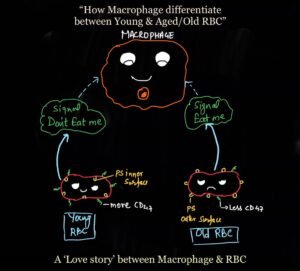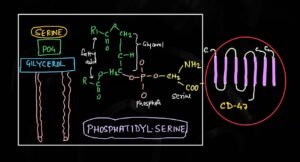Life of RBC
“A Love Story of RBC and Macrophages“
This is not very detail but basic information how aged (or 120 days red blood cells) RBC identified by Macrophages cells of Spleen, Liver and Bone Barrow and young RBC are not killed or break by Macrophages in the internal body environment.
here we understand role and dynamics of two very important chemicals namely
- CD47-Cluster of differentiation (a marker protein) localized on upper layer of RBC membrane
- PS-phosphatidylserine (a Phospholipid) localized in lower layer of RBC membrane.
In recognition of aged RBC and young RBC the amount of the CD47 and PS-Phosphatidylserine changing with the time.
In young RBC expression of CD47 is high while in aged (up to 120 days) RBC expression of CD47 expression is very less, which induce Erythrophagocytosis.
It means RBC which complete their life cycle (120 days) is ready to send signal to Macrophages to “eat me” while Young RBC which has not attain their 120 days triggered signal “don’t eat me”. That is “I am young” don’t damaged me. after destruction the Haemoglobin break down into amino acids, Fe(iron) and Haem.

Most of these chemicals are used to recycle back in the synthesis of new RBC in Bone marrow.
Although Bilirubin and Biliverdin pigments also formed in Liver by breakdown of Haem.
These pigments are important constituents of Bile Juice/Salt which is synthesize from Liver and stored and secreted from the Gall Bladder.
CD 47 (Cluster of Differentiation)
- Gene name-cd47
- Molecular Weight- 50 KDa
- Gene Location- in Humans Chromosome number:3 & in Mouse Chromosome number:16
It is a transmembrane protein which is involved in the cellular signaling process.
Such as- Apoptosis, Proliferation, Immunogenic and Angiogenic responses.
It has been noticed that this marker protein (CD47) is also over expressed in many tumor cells.
The gene encoded the cd47 marker protein located in chromosome number 3 in case of humans and chromosome number 16 in mouse.
CD47 is also known as integrin associated protein (IAP) and belongs to the protein of immunoglobulin super family.
It is joined with integrin and also shows interaction with legend thrombospondins-1 (TSP-1).
In addition, CD47 also interacts with signal regulatory protein Alpha (SIRP-alpha).

Role of CD47 Marker Protein
This protein plays an important role in-
- Adhesion
- Migration
- Immune response
- Help in generating don’t eat me signal from the RBC to macrophage
- Cell proliferation
- Apoptosis signaling
- Presently CD47 based Anti-CD47-Antibody used in macrophage mediated phagocytosis of cancerous or tumor cells.
Phosphatidylserine (PS)
As the name indicates, it is an acidic Phospholipid or more technically we can say Glycerophospholipid.
It has two fatty acid chains, a glycerol, an amino acid and a phosphate.
The amino acid is Serine, which is attached to the third carbon of Glycerol molecules by Phosphodiester bond.
Phosphatidylserine is found in about 13 to 15 percent composition in the Cerebral Cortex of the Human brain.
Site of Synthesis of PS
Phosphatidylserine synthesis takes place in the Endoplasmic reticulum (ER) of hepatic cells of the Liver.
The main enzyme is Phosphatidylserine synthase involved in the biosynthesis of Phosphatidylserine (PS).
Role of Phosphatidylserine
PS is localized in the lipid bilayer of the Plasma membrane located toward the Cytoplasmic area.
Phosphatidylserine involve in activation of many cell signaling pathway mostly related to Apoptosis process such as
Akt(PI3-Akt), Raf-1, Protein kinase c (PKC) signaling pathway, synaptogenesis process.
Source of Phosphatidylserine
The source of PS is from both plants as well as animals.
The plant source is Soy lecithin, White bean, unpolished rice, Carrot and Potato. However the content of Phosphatidylserine is less in plant based products.
The animal source of Phosphatidylserine is meat of different animals as well as from the fish flesh. The animal source contains a rich amount of Phosphatidylserine.
Phosphatidylserine is also available in the market in different brand names.

Blood
Lets under stand the very brief discription about the Blood.
Blood is fluidy connective tissue. The fluidy part is the plasma and tissue or cellular part is formed elements.
Components of Blood
Blood is made up of following parts.
- The first part is Blood plasma (formed 55% part of total blood)
- Second part Formed Elements (formed 45% part)
Plasma
It is the matrix part of blood which consists of water, organic, inorganic chemicals and dissolved gasses.
Formed Elements
It comprises Red Blood Cells (RBC), White Blood Cells (WBC) and Blood platelets or Thrombocytes.
Among these, the number of red blood cells is the highest among the cells found in the blood.
Functions of RBC
Red blood cells mainly carry oxygen throughout the body from the lungs and carry some amount of carbon dioxide gas from different parts of the body to the lungs.
The red pigment found in these is hemoglobin, due to which their color is red.
Hemoglobin itself combines with oxygen and forms oxyhemoglobin and then carries it to different parts of the body.
Where there is a lack of oxygen, it again splits into hemoglobin and oxygen.
Due to which oxygen enters the cells and hemoglobin is ready to bind with oxygen again.
Function of Blood
Everyone knows that blood is called the river of the body and it primarily involves in transports of chemicals process. Some common function of blood are-
- After digestion of food in Alimentary canal, the digested food materials transported by the blood.
- Blood serves to carry and bring Respiratory gasses (carbon dioxide and oxygen) from & to lungs alveoli or air sac.
- Blood also regulates the temperature.
- Blood clotting, which is the multistep biochemical reaction completed by involvements of different factors. it is also the preventive measures which prevent from the excessive loss of blood in injury.
- Blood also help in the transport of nitrogenous waste that is Urea from the Liver to Kidney where it is after ultra filtration converted in urine.
- Blood contains antibodies molecule which prevents from the harmful pathogen.
- Albumin is another protein present in the blood helps in osmoregulation.
Conclusion
According to the above description it is clear that how nature design a system in our body which evolves specifically to discriminate between aged and young RBC.
You may also enjoy reading this post.
If any mistakes or any suggestion from your side please mention in comments
Thanks for reading this Post.

